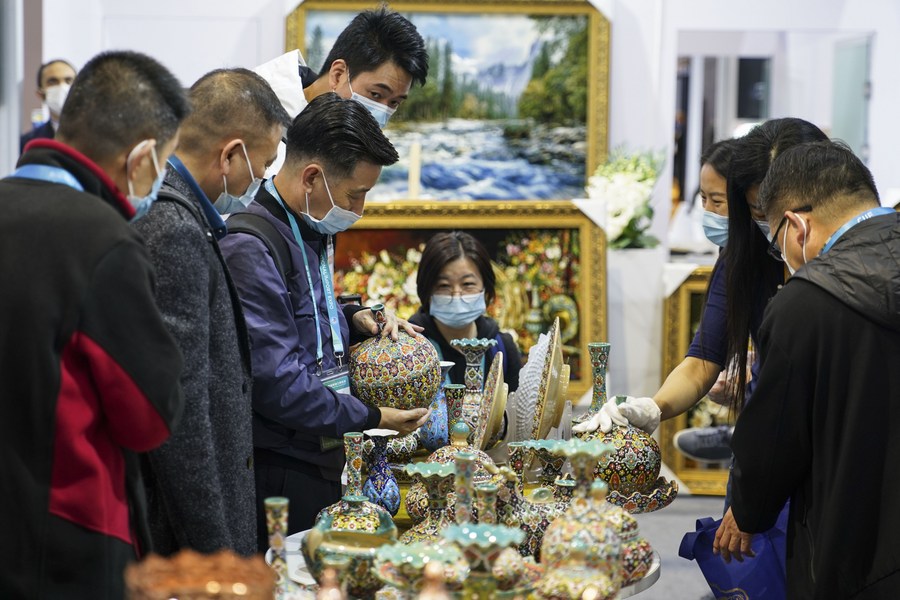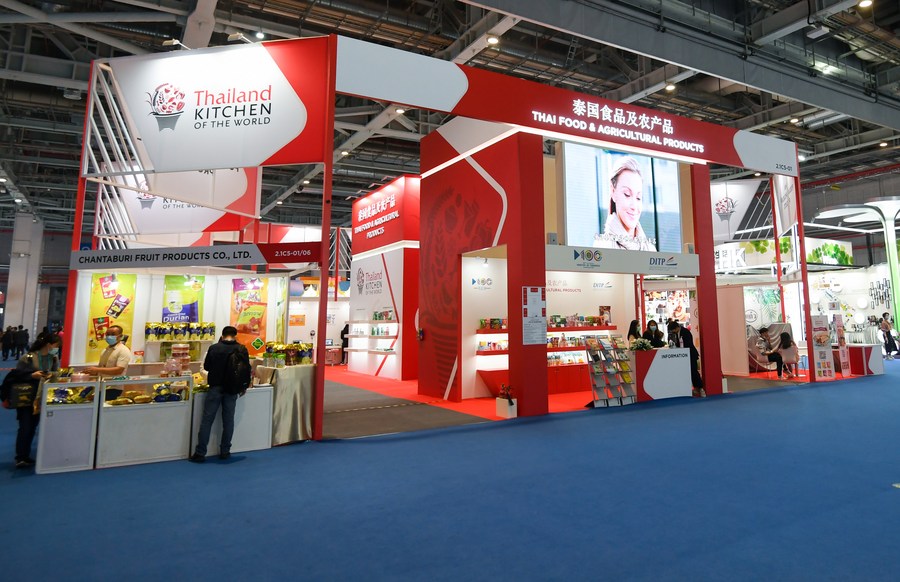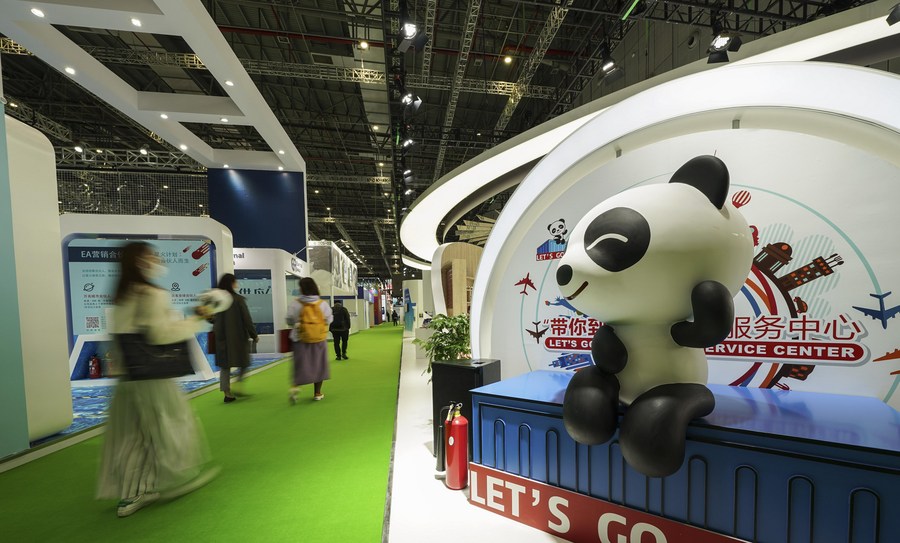CIIE: Expo provides impetus for economic recovery along Belt and Road
At the exhibition booth for products from Kazakhstan, Makhanbet explains about the camel milk powder and mare milk powder that his company is selling at the third China International Import Expo (CIIE) in Shanghai.
"The camel milk is easy to digest, nutritious, and rich in calcium," Makhanbet told a professional buyer.
Makhanbet, 26, is an agent of Eurasia Investment Co., Ltd from Kazakhstan. This year, the company has sold about four tonnes of camel milk to China and expects to sell more.
"The exhibition is quite important for us," said Meruyert Rakhimberdiyeva, the company's international exports manager.
Scores of the Central Asian country's enterprises are participating in this year's CIIE, bringing with them milk products, frozen foods, beverages, groceries and sweets.

People visit the booth of Iran at the Consumer Goods exhibition area during the third China International Import Expo (CIIE) in Shanghai, east China, Nov. 8, 2020. (Xinhua/Zhang Haofu)
The CIIE is providing impetus to aid the economic recovery of countries along the Belt and Road (B&R), presenting opportunities for enterprises from these areas at a time when the COVID-19 pandemic is adding to uncertainties and challenges.
China is the first major economy to return to growth after the economic fallout of the COVID-19 epidemic, with its economy expanding 0.7 percent year on year in the first nine months.
In the same period, the country's foreign trade in goods totaled 23.12 trillion yuan (about 3.5 trillion U.S. dollars), up 0.7 percent year on year, and paid-in foreign investment rose 5.2 percent from a year earlier.
China has now become the largest trading partner of more than 120 countries and regions. It has signed 200 cooperation documents with 138 countries and 30 international organizations, and carried out more than 2,000 cooperation projects within the framework of the Belt and Road Initiative.
China also aims to promote high-quality development in the joint construction of the Belt and Road in the next five years and beyond, according to the central authorities' recent decision on formulating the 2021-2025 plan for national economic and social development.
Against this backdrop, many enterprises from the B&R partner countries have come to the national-level expo in Shanghai to seek more potential business, trying to rise above the impact of COVID-19.
More than 500 enterprises from 47 B&R countries have participated in this year's CIIE, with an exhibition area of about 40,000 square meters, according to the expo organizer.

Photo taken on Nov. 7, 2020 shows the exhibition hall of the Thai Food and Agricultural Products at the Food and Agricultural Products exhibition area during the third China International Import Expo (CIIE) in Shanghai, east China. (Xinhua/Chen Yehua)
Authorities have also set up 20 national pavilions for B&R countries in the Greenland Global Commodity Trading Hub next to the National Exhibition and Convention Center (Shanghai), where the expo is taking place, according to Xue Yingjie, general manager of the Greenland Global Commodity Trading Hub Group.
More than 300 small and medium-sized enterprises from B&R countries are presenting more than 10,000 products at the hub, Xue said.
A BRIDGE FOR GLOBAL ENTERPRISES
For many enterprises from B&R countries, the expo is a major exchange platform to communicate, exhibit their products, make their brands known to the Chinese public and find business partners.
Afaf Rais, commercial director of IntelCare, a Moroccan cosmetics company, spoke about the firm's experience during the previous two editions of the CIIE. "We met with several Chinese distributors and welcomed several customers to our stand to exchange opinions. It was very useful to understand the Chinese customers and adapt to their expectations," she said.
The commercial director said that, with the help of the third edition of the CIIE, the company has set a goal of finalizing distribution agreements and achieving annual sales of around 1 million U.S. dollars in the Chinese market in 2020.
Meanwhile, Watergen, an Israeli high-tech company, is presenting its unique patented technology with the ability to turn humidity in the air into a source of high-quality drinking water. It has put several of its machines on display, from small ones for home use to big ones for public spaces.
"This is the second time for Watergen to participate in the CIIE," Michael Mirilashvili, president and CEO of Watergen, said. "The second CIIE held in 2019 brought great opportunities for us."
After participating in the second CIIE, Watergen attracted some 200 companies to discuss cooperation.

A staff member shows Watergen's unique patented technology with the ability to turn humidity in the air into a source of high quality drinking water at Watergen Headquarters in Petah Tickva, Israel, Nov. 1, 2020. (Xinhua/Shang Hao)
The CIIE serves as a bridge for global enterprises to directly reach the Chinese market and tap substantial business opportunities, said Deemah Sukhtian, managing director of Munir Sukhtian Group, a Jordanian family business trading in various areas.
"China plays a significant role in global trade and economy, where we've been trying to approach and see how we can collaborate on both imports and exports," Sukhtian said.
China National Machinery Industry Corporation Ltd, a state-owned machinery conglomerate, said it will sign agreements on project cooperation with three Belt and Road countries, including an electrolytic aluminum project in Belarus, which will be funded by Belarus and built by China.
"We are delighted that China has maintained its decision to hold the expo on Nov. 5 as scheduled, despite the COVID-19 pandemic, because we consider the third CIIE as a key event for our target country: China," Serap Unal, deputy secretary general of the Aegean Exporters' Association, told Xinhua.
Unal indicated that Turkish enterprises value this event highly as it enhances the image of Turkish products among Chinese consumers.
"We have an increasing amount of food product exports to China. In 2015, the amount was 131 million U.S. dollars, while in 2019 we reached 226 million dollars," she said. "The Chinese market is very important for us."
AN IMPETUS FOR B&R COUNTRIES
China's trade with B&R countries remains strong despite COVID-19.
During the first nine months of 2020, Chinese enterprises made a direct investment of over 91 billion yuan in non-financial sectors in 57 Belt and Road countries, up 32.3 percent year on year.
According to the General Administration of Customs, during the first three quarters of 2020, China's imports and exports to countries along the Belt and Road totaled 6.75 trillion yuan, up 1.5 percent from the same period last year.

Visitors are seen at the Trade in Services exhibition area during the third China International Import Expo (CIIE) in Shanghai, east China, Nov. 5, 2020. (Xinhua/Zhang Haofu)
Liu Huaqin, with the Chinese Academy of International Trade and Economic Cooperation, said that China is an attractive market for countries in Europe and Asia, and their presentation of products at the expo allows Chinese consumers to get better access to their products, and this can help open up the Chinese market for them.
"The CIIE will strengthen the connection between enterprises, while providing a precious opportunity to enhance mutual trade," Liu said.
Quan Heng, an economist with the Shanghai Federation of Social Science Associations, said as the Belt and Road Initiative was proposed by China, China has taken a variety of measures to help B&R countries find market opportunities in the country.
"The expo is one of the major measures of China's opening-up," Quan said. "With the CIIE taking place as scheduled, China has managed to build a major platform for B&R countries to enhance trade and display products and services."
China is powering ahead with a new "dual circulation" development pattern, where domestic and foreign markets complement and reinforce each other, with the domestic market as the mainstay. By hosting the expo and welcoming B&R countries, China helps the enterprises get new impetus for development, according to Quan.
"The expo not only helps with the resumption of work and production in B&R countries, but also allows the companies to find new directions in the market," Quan added.